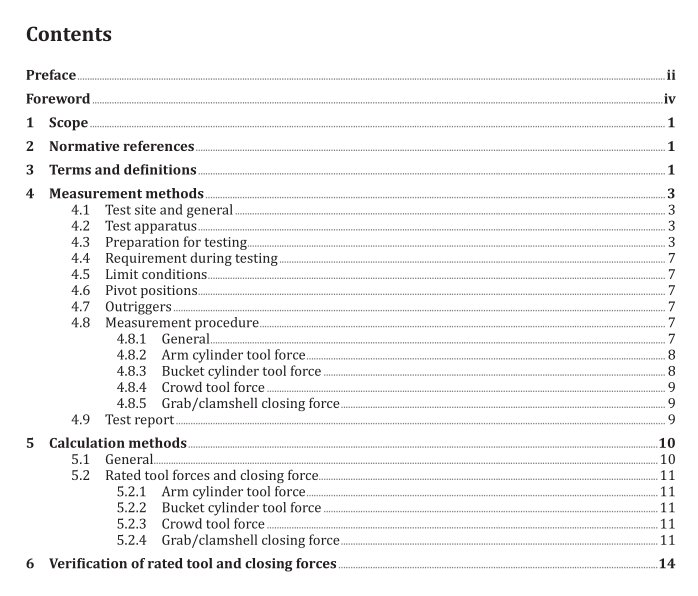AS ISO 6015 pdf download – Earth-moving machinery — Hydraulic excavators and backhoe loaders — Methods of determining tool forces

AS ISO 6015 pdf download – Earth-moving machinery — Hydraulic excavators and backhoe loaders — Methods of determining tool forces
1 Scope
This International Standard specifies methods for measuring and calculating the tool forces of earth-moving attachments fitted to hydraulic excavators and the hoe equipment of backhoe loaders. It isapplicable to hydraulic excavators and backhoe loaders as defined in IS0 6165.
2Normative references
The following referenced documents are indispensable for the application of this document. For datedreferences, only the edition cited applies.For undated references, the latest edition of the referenceddocument (including any amendments) applies.
ISO 6016:1998,Earth-moving machinery — Methods of measuring the masses of whole machines, theirequipment and components
ISO 6165,Earth-moving machinery — Basic types — ldentification and terms and definitions
ISO 6746-1:2003,Earth-moving machinery —Definitions of dimensions and codes —Part 1: Base machineISO 7135:1993,Earth-moving machinery — Hydraulic excavators — Terminology and commercialspecifications
ISO7451:1997,Earth-moving machinery— Volumetric ratings for hydraulic excavator buckets and backhoeloader buckets
ISO 7546:1983,Earth-moving machinery – Loader and front loading excavator buckets 一Volumetric ratings
ISO 9248:1992,Earth-moving machinery —Units for dimensions, performance and capacities, and theirmeasurement accuracies
3Terms and definitions
For the purposes of this document, the following terms and definitions apply.3.1
tool force
force generated at the bucket lip or cutting edge, but not at the tips of the teeth, when operating thebucket or arm cylinders independently
3.2
arm cylinder tool force
force generated at the bucket lip with the arm cylinder positioned to provide a rotating moment aroundthe arm pivot
Note 1 to entry: The bucket lip moves towards the base machine when hoe equipment is used.3.3
arm cylinder tool force at level crowd
(shovel equipment) horizontal arm cylinder tool force generated by the arm cylinder at the bucketlip when the bucket”s attitude is level and maintained parallel to the ground line and the lip is atthe ground line
3.4
bucket cylinder tool force
tool force generated at the bucket lip with the bucket cylinder(s) positioned to provide a rotatingmoment to the bucket around its pivot
Note 1 to entry:The bucket lip moves towards the base machine when hoe equipment is used and away from itwhen shovel equipment is used.
3.5
crowd tool force
《hydraulic excavators with telescoping boom) tool force generated at the bucketlip when the telescopingboom is retracted
3.6
rated tool force
tool force, measured or calculated, that the manufacturer publishes3.7
actual tool force
measured tool force generated at the bucket without tipping or sliding occurring3.8
maximum [arm cylinder] [bucket cylinder] [crowd]tool forcelargest measured or calculated tool force
3.9
grab [clamshell] closing force
force generated between the grab[clamshell] cutting edges or teeth tips when closing3.10
maximum grab [clamshell] closing force
largest measured or calculated grab [clamshell] closing force3.11
arm force radiusA
radius of the arc that passes through the bucket lip and whose centre is located at the arm pivotNote 1 to entry: See Figure 5
3.12
bucket force radiusB
radius of the arc that passes through the bucket lip and whose centre is located at the bucket pivotNote 1 to entry: See Figure 6
3.13
grab[clamshell] force radiusc
radius of the arc that passes through the grab or clamshel lip and whose centre is located at the grab orclamshell pivot
Note 1 to entry: See Figure 7
4 Measurement methods
4.1 Test site and general The test site shall consist of a level, hard surface, with anchor points and space for using the measuring devices specified in 4.2.1 to 4.2.3. For measurements made below the ground plane, a space below that plane is required for acceptance of the machine tool and the measurement devices, the anchorage and any auxiliary equipment. All measurements shall be accurate to within ± 2 % or shall accord with an International Standard relative to test equipment accuracy. In the preferred method, the force to be measured is applied directly to the force measuring device (4.2.1). If the force is applied via a pulley, its friction should be taken into account. The wire rope (4.2.4) should be as short as possible to minimize the affect on accuracy.









